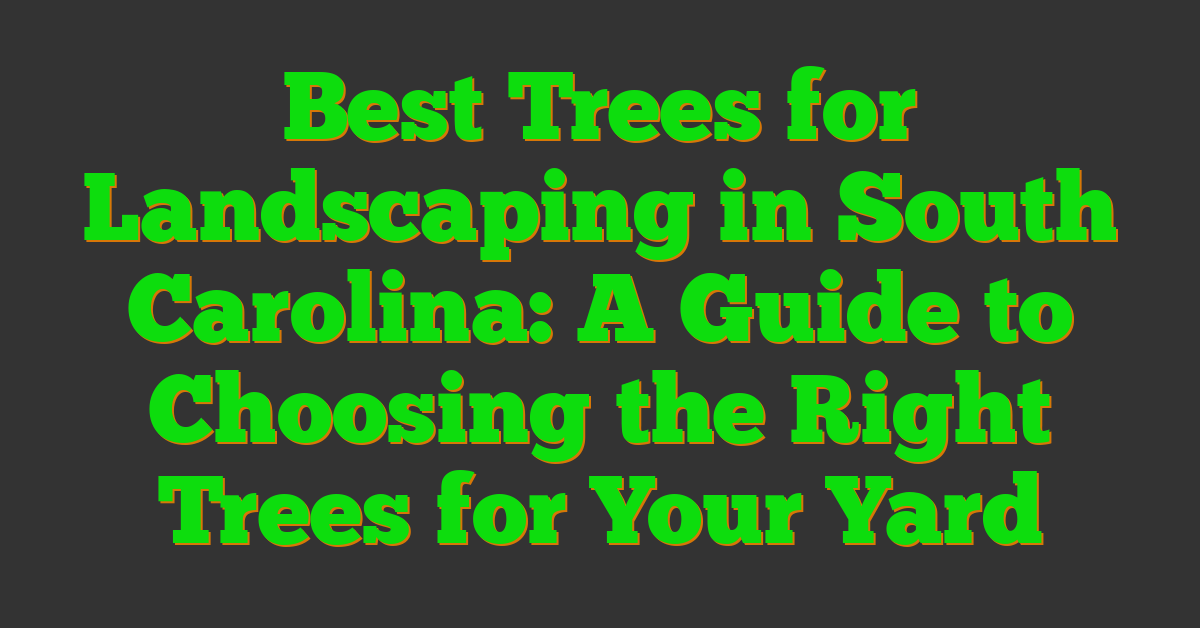If you’re looking to add some natural beauty to your South Carolina property, planting trees is an excellent way to do so. Not only do trees add aesthetic value to your landscaping, but they also provide numerous environmental benefits such as improving air quality, reducing soil erosion, and providing habitats for wildlife. However, selecting the right trees for your property can be a daunting task, especially if you’re not familiar with the local climate and soil conditions.

South Carolina’s diverse landscape ranges from coastal wetlands to mountainous regions, and the state experiences a humid subtropical climate with hot summers and mild winters. Understanding the unique characteristics of South Carolina’s landscape is crucial when selecting trees for your landscaping. Native trees are an excellent choice as they are adapted to the local climate and soil conditions and require less maintenance than non-native species.
Planting native trees not only benefits the environment but also adds value to your property. According to a study by the University of Washington, landscaping can increase property values by up to 20 percent. In this article, we’ll explore the best trees for landscaping in South Carolina, how to select trees based on seasons, soil and climate conditions, and how to care for your trees to ensure they thrive.
Key Takeaways
- Understanding South Carolina’s unique landscape is crucial when selecting trees for your landscaping.
- Planting native trees benefits the environment and increases property values.
- Selecting trees based on seasons, soil and climate conditions, and proper care are important factors in ensuring your trees thrive.
Understanding South Carolina’s Landscape

https://www.youtube.com/watch?v=lwJDfVKo3fk&embed=true
If you’re planning to add some trees to your South Carolina landscaping, it’s essential to understand the state’s landscape. South Carolina’s landscape is diverse, with the Blue Ridge Mountains to the west and the Coastal Plain to the east. The Piedmont region is in the middle, making up the transition zone between the mountains and the coast.
The climate in South Carolina is humid subtropical, which means hot summers and mild winters. The average annual temperature is around 62°F. The state receives plenty of rainfall throughout the year, with an average of 48 inches per year. However, the amount of rainfall varies depending on the region. The coastal areas receive more rainfall than the inland areas.
The soil type in South Carolina varies depending on the region. The Coastal Plain has sandy soil, while the Piedmont region has clay soil. The Blue Ridge Mountains have rocky soil. Understanding the soil type in your region is essential when selecting trees for your landscaping.
The Blue Ridge Mountains have a different climate and soil type than the rest of the state. If you live in the Blue Ridge region, you’ll want to select trees that are adapted to the cooler temperatures and rocky soil.
South Carolina is located in the southeastern United States, which means it has a diverse range of native trees. Some of the most popular native trees in South Carolina include the oak, maple, dogwood, and magnolia. These trees are adapted to the state’s climate and soil type, making them an excellent choice for landscaping.
Overall, understanding South Carolina’s landscape is essential when selecting trees for your landscaping. Consider the climate, soil type, and rainfall in your region when selecting trees. Choose trees that are adapted to your region for the best results.
The Importance of Native Trees
https://www.youtube.com/watch?v=iKZbxrQzB7g&embed=true
When it comes to landscaping in South Carolina, choosing native trees can have a significant impact on your yard’s health and the environment. Native trees are those that have evolved and adapted to the local climate, soil, and wildlife over thousands of years. They are an essential part of the state’s plant communities, and planting them can help maintain the state’s biodiversity.
The U.S. Forest Service recommends planting native species to support the local ecosystem. Native trees require less maintenance and are more resistant to pests and diseases than non-native species. They also provide food and habitat for local wildlife, including birds, insects, and mammals.
In addition to their environmental benefits, native trees can also be more cost-effective. Local seed sources are often less expensive than imported seeds, and native trees require less water and fertilizer than non-native species.
Choosing native trees can also help maintain the state’s unique character. South Carolina is home to a variety of beautiful and iconic trees, such as the live oak, magnolia, and dogwood. By planting these trees in your yard, you can help preserve the state’s natural beauty.
Overall, planting native trees is a simple and effective way to support the local ecosystem while enhancing your yard’s beauty and value. So next time you’re considering landscaping in South Carolina, be sure to choose native trees.
Popular Trees for Landscaping
https://www.youtube.com/watch?v=9fnjeyJG06M&embed=true
If you’re looking to add some trees to your South Carolina landscaping, you have plenty of options to choose from. Some of the most popular trees for landscaping in South Carolina include:
Magnolia Trees
Magnolia trees are a popular choice for South Carolina landscaping. With their large, fragrant flowers and glossy green leaves, they add a touch of elegance to any yard. There are several species of magnolia trees to choose from, including the Southern Magnolia and the Sweetbay Magnolia.
Oak Trees
Oak trees are another popular choice for South Carolina landscaping. They come in a variety of species, including the Live Oak, Red Oak, and White Oak. Oak trees are known for their strong, sturdy trunks and their beautiful, dense foliage.
Maple Trees
Maple trees are a great choice for South Carolina landscaping because they offer a variety of colors throughout the year. In the fall, their leaves turn brilliant shades of red, orange, and yellow. Some popular species of maple trees include the Red Maple, Sugar Maple, and Japanese Maple.
Crabapple Trees
Crabapple trees are a beautiful addition to any South Carolina yard. They are known for their stunning spring blooms and their bright, colorful fruit. Some popular species of crabapple trees include the Prairiefire Crabapple and the Royal Raindrops Crabapple.
Bald Cypress Trees
Bald Cypress trees are a unique choice for South Carolina landscaping. They are known for their distinctive, cone-shaped trunks and their beautiful, feathery foliage. Bald Cypress trees are also great for wet areas, as they can tolerate standing water.
« Best Trees for Landscaping in Rhode Island: A Guide to Choosing the Right Trees for Your Yard Best Trees for Landscaping in South Dakota: A Guide to Choosing the Right Trees for Your Yard »
Evergreens
Evergreens are a great choice for South Carolina landscaping because they stay green all year round. Some popular species of evergreens include the Leyland Cypress, the Eastern Red Cedar, and the American Holly. Evergreens are also great for creating privacy barriers and windbreaks.
No matter what type of tree you choose for your South Carolina landscaping, make sure to choose a species that is well-suited to your climate and soil conditions. With the right care, your trees will thrive and add beauty to your yard for years to come.
Tree Selection Based on Seasons
https://www.youtube.com/watch?v=48neQIeCuvE&embed=true
When selecting trees for your landscaping in South Carolina, it’s important to consider the seasons. Different trees will thrive in different seasons, and some trees will be more colorful or have more visual impact during certain times of the year.
In the spring, you may want to choose trees that bloom with colorful flowers. Dogwood trees are a popular choice for their pink or white blooms, as are cherry trees and magnolia trees. These trees will add a pop of color to your landscape and are sure to impress your neighbors.
During the fall, you may want to choose trees that provide colorful foliage. Maple trees are a classic choice for their bright reds, oranges, and yellows. Oak trees also provide beautiful fall foliage with their deep reds and browns. Consider planting these trees near each other to create a stunning display of fall colors.
In the summer, you may want to choose trees that provide shade and relief from the heat. Oak trees, maple trees, and elm trees are all great choices for their large canopies and ability to provide ample shade. These trees will also help keep your home cooler during the hot summer months.
During the winter, you may want to choose trees that provide interesting visual impact without their leaves. Evergreen trees, such as pine trees and spruce trees, will provide year-round greenery and can be used as a backdrop for other trees and plants in your landscape. Additionally, trees with interesting bark, such as birch trees and sycamore trees, will add visual interest to your landscape during the winter months.
It’s important to consider how your trees will interact with each other throughout the seasons. For example, if you have a tree that blooms in the spring, you may want to plant a tree nearby that will provide shade during the summer months. Additionally, you may want to consider how the colors of your trees will interact with each other throughout the year.
Overall, selecting trees based on the seasons is an important consideration when planning your landscape in South Carolina. By choosing trees that provide visual impact throughout the year, you can create a beautiful and engaging landscape that will be the envy of your neighborhood.
Understanding Soil and Climate Conditions
https://www.youtube.com/watch?v=GW5l3acAB3Q&embed=true
When it comes to landscaping in South Carolina, one of the most important factors to consider is the soil and climate conditions. Understanding these conditions will help you choose the best trees that will thrive in your area. Here are some key things to keep in mind:
Soil Types
South Carolina has a variety of soil types, including clay, loam, and sand. Each soil type has its own unique characteristics that can affect tree growth. For example, clay soil tends to hold more water, which can lead to root rot if not properly drained. Loam soil, on the other hand, is a balanced soil type that provides good drainage and nutrient retention. Sand soil drains quickly and doesn’t retain nutrients well, which can lead to nutrient deficiencies in trees.
Moisture
Moisture is also an important factor to consider when selecting trees for your landscape. Some trees prefer moist soil, while others prefer well-drained soil. Make sure to choose trees that are suited to the moisture level in your area.
Sunlight
Different trees have different sunlight requirements. Some trees prefer full sun, while others prefer partial shade. Make sure to choose trees that are suited to the amount of sunlight in your landscape.
Temperature
South Carolina has a humid subtropical climate, which means that summers are hot and humid, while winters are mild. When selecting trees, make sure to choose trees that are adapted to the temperature range in your area.
Nutrients
Trees need a variety of nutrients to grow, including nitrogen, phosphorus, and potassium. Make sure to choose trees that are adapted to the nutrient levels in your soil.
In summary, understanding the soil and climate conditions in your area is crucial when selecting trees for your landscape. Make sure to choose trees that are adapted to the moisture level, sunlight, temperature, and nutrient levels in your area.
Caring for Your Trees
Congratulations on planting your new trees! Now that they are in the ground, it’s important to take proper care of them so they can thrive in your South Carolina landscape. Here are some tips to help your trees grow healthy and strong:
Watering
Watering is crucial for the health of your trees. Newly planted trees need to be watered regularly, especially during the first few months after planting. Water deeply, making sure the soil is moist at least 6 inches below the surface. During dry spells, continue to water your trees once a week. Be careful not to overwater, as this can lead to root rot.
Fertilizer
Fertilizer can help your trees grow faster and stronger. Apply a slow-release fertilizer in the spring, and again in the fall. Be sure to follow the manufacturer’s instructions for application rates and methods.
Light and Shade
Different trees have different light requirements. Some trees, such as dogwoods and redbuds, prefer partial shade, while others, like oaks and maples, need full sun. Be sure to plant your trees in the appropriate location for their light requirements.
Maintenance
Regular maintenance is important to keep your trees healthy. Prune dead or damaged branches, and remove any suckers that grow from the base of the tree. Mulch around the base of the tree to help retain moisture and control weeds.
Water Conservation
Conserving water is important for the environment and your wallet. Consider using a drip irrigation system to water your trees, as this can be more efficient than traditional sprinklers. Also, use mulch around the base of your trees to help retain moisture in the soil.
By following these tips, you can help your trees thrive in your South Carolina landscape. Remember to give them the care they need, and they will reward you with years of beauty and enjoyment.
Trees and Wildlife
https://www.youtube.com/watch?v=CNjebu_I8kE&embed=true
When planning your landscaping, it’s important to consider the impact it will have on the wildlife in your area. Trees are a key component in providing habitat for a variety of animals, from birds to squirrels to insects. Here are some things to keep in mind when choosing trees for your yard:
Wildlife Habitat
Certain trees are better suited for providing habitat for wildlife than others. Native trees are generally the best choice, as they are adapted to the local climate and provide food and shelter for native animals. Some examples of trees that provide good habitat include oak trees, which provide acorns for squirrels and other animals, and dogwood trees, which provide berries for birds.
Wildflowers and Flowering Plants
In addition to trees, incorporating wildflowers and flowering plants into your landscaping can provide food and habitat for pollinators like bees and butterflies. Consider planting flowers like black-eyed Susans, coneflowers, and butterfly weed, which are all native to South Carolina and attract pollinators.
Breeding and Migration
Trees can also play a role in providing breeding and migration habitat for birds. Some species of birds rely on certain types of trees for nesting, while others use trees as a stopping point during migration. When choosing trees for your yard, consider whether they will provide the necessary habitat for the birds in your area.
Pests
While trees can provide habitat for beneficial insects, they can also attract pests like aphids and scale insects. When choosing trees for your yard, consider whether they are prone to pest problems and whether you are willing to deal with the potential issues.
Pollinators
Finally, it’s important to consider the role that trees play in providing food and habitat for pollinators. Bees and other pollinators are crucial for the health of our ecosystem, and trees can provide a valuable source of nectar and pollen. Consider planting trees like redbuds, which provide early-season nectar for bees, or tulip poplars, which provide nectar for hummingbirds.
By choosing trees that provide good habitat for wildlife, you can create a beautiful and functional landscape that benefits both you and the environment.
Potential Threats to Trees
As you plan your landscaping in South Carolina, it’s important to be aware of potential threats to your trees. Here are some factors to keep in mind:
Invasive Species
Invasive species can quickly take over and harm native trees. Some common invasive species in South Carolina include the Chinese privet, kudzu, and Japanese honeysuckle. Be sure to research any plants you’re considering adding to your landscaping to ensure they aren’t invasive.
Diseases
Trees can be susceptible to a variety of diseases, including oak wilt, Dutch elm disease, and dogwood anthracnose. Keep an eye out for signs of disease, such as wilting leaves or discolored bark, and take action promptly if you suspect a problem.
Pesticides
While pesticides can be effective in controlling pests, they can also harm beneficial insects and wildlife. Be sure to use pesticides sparingly and only when necessary.
Non-Native Species
Non-native species may look attractive, but they can also harm the local ecosystem. Stick with native species whenever possible to support local wildlife and maintain biodiversity.
Endangered and Threatened Species
Some trees in South Carolina are endangered or threatened, such as the American chestnut and the Ashe magnolia. If you’re considering planting a rare or protected species, be sure to do your research and follow proper guidelines to ensure you’re not contributing to their decline.
Habitat Loss and Extinction
Habitat loss is a major threat to trees and other wildlife in South Carolina. When planning your landscaping, consider ways to support local habitats, such as providing food and shelter for birds and other animals.
By being aware of these potential threats and taking steps to mitigate them, you can help ensure that your trees thrive and contribute to a healthy ecosystem in South Carolina.
Landscaping and Property Value
https://www.youtube.com/watch?v=iDuU6Q4SU8I&embed=true
When it comes to landscaping your property, choosing the right trees can greatly increase its value. Trees not only enhance the beauty of your garden but also provide a sense of privacy and shade. According to a study by the University of Washington, landscaping can increase the value of a property by up to 20%. Trees are an essential element of landscaping and can significantly contribute to this value.
The height and space of trees are crucial factors to consider when landscaping. Trees that grow too tall or too wide can interfere with power lines, the lawn, and even the streets. It is important to choose trees that are appropriate for the space and location. Consulting with professional landscapers can help you determine which trees are best suited for your property.
A well-designed garden with appropriate trees can add to the beauty and charm of your property. Landscaping with trees can also provide an opportunity to create a unique and personalized outdoor space. With the right trees, you can create a garden that reflects your style and personality.
In summary, landscaping with trees can greatly increase the value of your property. Choosing the right trees that fit the space and location is essential. With the help of professional landscapers, you can create a beautiful and unique garden that enhances the charm of your property.
Resources and Additional Information
https://www.youtube.com/watch?v=Kg-o1AhkCOg&embed=true
If you’re looking for more information on landscaping with trees in South Carolina, there are several resources available to you. Here are a few places to start:
- Clemson University Extension: Clemson University has an extensive online resource library with information on everything from tree selection to pruning. Their website is a great place to start if you’re looking for in-depth information on tree care and maintenance.
- Palmetto State: Palmetto State is a South Carolina-based garden center that specializes in native plants. They offer a wide selection of trees that are well-suited to the local climate and soil conditions.
- Federal Government: The United States Department of Agriculture (USDA) has a wealth of information on tree planting and care. Their website includes resources on everything from selecting the right tree species to dealing with pests and diseases.
- Plantings: If you’re looking for inspiration for your landscaping project, consider visiting some local plantings. Many public parks and botanical gardens have extensive collections of trees and other plants, and can be a great source of ideas.
No matter where you turn for information, be sure to do your research before selecting and planting any trees. With the right care and attention, your trees can provide years of beauty and enjoyment for you and your family.
Frequently Asked Questions
https://www.youtube.com/watch?v=QRl3puYcC6M&embed=true
What are some small shade trees that grow well in South Carolina?
If you are looking for small shade trees that grow well in South Carolina, you can consider planting the Japanese maple, dogwood, or redbud. These trees provide beautiful foliage and can thrive in the climate of South Carolina.
What are some fast-growing evergreen trees that are native to South Carolina?
If you are looking for fast-growing evergreen trees that are native to South Carolina, you can consider planting the Southern magnolia, longleaf pine, or Loblolly pine. These trees can provide year-round foliage and can grow quickly.
What are some types of trees that are commonly found in South Carolina?
South Carolina is home to a variety of trees, including oak, pine, hickory, and maple. Other common trees found in South Carolina include sweetgum, black gum, and tulip poplar.
What are some of the best privacy trees to plant in South Carolina?
If you are looking for privacy trees to plant in South Carolina, you can consider planting the Leyland cypress, Eastern red cedar, or American holly. These trees can grow tall and provide a natural barrier for privacy.
What are some fast-growing shade trees that are suitable for small yards?
If you have a small yard but still want a shade tree, you can consider planting the crepe myrtle, fringe tree, or flowering dogwood. These trees grow relatively quickly and can provide shade without taking up too much space.
What are some of the best shade trees to plant in a backyard in South Carolina?
If you are looking for shade trees to plant in your backyard in South Carolina, you can consider planting the live oak, Southern magnolia, or American beech. These trees can grow large and provide ample shade for your backyard.


















